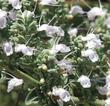Salvia apiana
White Sage.
Salvia apiana, White sage is a five foot evergreen perennial. The flowers emerge in summer and are white with a little lavender. They pucker-back with the stamens hanging out to the sides. White sage gives the bees fits because they can't get in and out very well. Bumblebees seem to be able to fight their way in and hummingbirds figure it out. White sage leaves start out crinkly grey/green and become smooth white.
A sage native to the southern coast ranges, into inner mountains. Salvia apiana likes sunny dry slopes, almost gravelly soil and no extra water after first year. Some companion plants are Eriogonum fasciculatum, California Buckwheat; Salvia mellifera, Black sage; Hollyleaf Cherry, Prunus ilicifolia; Rhus ovata, Sugar Bush; Rhus integrifolia, Lemonade Berry,; and Artemisia californica, California Sagebrush. It is not specific to one soil, growing in sandy loam, granitic scree, and red loamy clay. In the garden if it is happy it makes a very large flower spike (5') with 100+ 1" flowers.
White sage is hardy to about 15 F. here in the central coast ranges, but is more hardy in the desert areas. In its range it receives between 6-26" of rain/year.
This is one of the sages used in sweat lodges in the past and apartments in the present. Most of the stuff sold in the upscale trendy places was ripped out of the wild; whole hillsides stuffed into an old van and driven to San Francisco or Seattle or even New York so people can experience something. Well, the hillsides of southern California do not need the experience; go burn old socks or something to experience what the hillsides are experiencing. If you do buy one of these burn sticks, may your soul go with the smoke. Curse on you. (Especially the lady that called up protesting the curse.)
We sell gallon plants we grow from nursery-grown plants. Plant a few white sage for your own sticks and a few for your friends. If you only have a small yard look at the Compact White Sage, the leaves are about the same size but the plants are smaller. If you're in the Midwest look at Artemisia ludoviciana, White Sagebrush as that was the smudge plant of that area.
This plant has lead to some interesting questions: "Would you define the Salvia apiana leaf 'fragrance/scent' for me? We are trying to develop a Salvia apiana scented votive... Our response, kinda like sage/pine needles/burning rubber/skunk. Burn that in your pipe!
Here's a native sage page where you can see all the sages of California.
Salvia apiana tolerates sand and clay.
Salvia apiana is great for a bird garden.
Foliage of Salvia apiana has color silver, is evergreen and has fragrance.
Flower of Salvia apiana has color white and has a fragrance.
Communities for Salvia apiana:Chaparral, Coastal Sage Scrub and Yellow Pine Forest.
| ph: | 6.00 to 8.00 |
|---|---|
| usda: | 9 to 10 |
| height[m]: | 0.70 to 2.00 |
| width[m]: | 1.00 to 2.00 |
| rainfall[cm]: | 40.00 to 105.00 |






